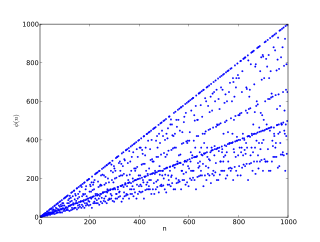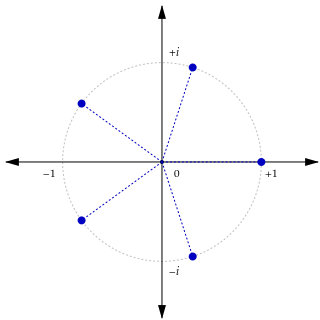In number theory, a multiplicative function is an arithmetic function f(n) of a positive integer n with the property that f(1) = 1 and
In abstract algebra, the field of fractions of an integral domain is the smallest field in which it can be embedded. The construction of the field of fractions is modeled on the relationship between the integral domain of integers and the field of rational numbers. Intuitively, it consists of ratios between integral domain elements.

The Riemann zeta function or Euler–Riemann zeta function, denoted by the Greek letter ζ (zeta), is a mathematical function of a complex variable defined as

In mathematics, a square-free integer (or squarefree integer) is an integer which is divisible by no square number other than 1. That is, its prime factorization has exactly one factor for each prime that appears in it. For example, 10 = 2 ⋅ 5 is square-free, but 18 = 2 ⋅ 3 ⋅ 3 is not, because 18 is divisible by 9 = 32. The smallest positive square-free numbers are

In number theory, Euler's totient function counts the positive integers up to a given integer n that are relatively prime to n. It is written using the Greek letter phi as or , and may also be called Euler's phi function. In other words, it is the number of integers k in the range 1 ≤ k ≤ n for which the greatest common divisor gcd(n, k) is equal to 1. The integers k of this form are sometimes referred to as totatives of n.
The Liouville lambda function, denoted by λ(n) and named after Joseph Liouville, is an important arithmetic function. Its value is +1 if n is the product of an even number of prime numbers, and −1 if it is the product of an odd number of primes.

In mathematics, a root of unity, occasionally called a de Moivre number, is any complex number that yields 1 when raised to some positive integer power n. Roots of unity are used in many branches of mathematics, and are especially important in number theory, the theory of group characters, and the discrete Fourier transform.

The abc conjecture is a conjecture in number theory that arose out of a discussion of Joseph Oesterlé and David Masser in 1985. It is stated in terms of three positive integers and that are relatively prime and satisfy . The conjecture essentially states that the product of the distinct prime factors of is usually not much smaller than . A number of famous conjectures and theorems in number theory would follow immediately from the abc conjecture or its versions. Mathematician Dorian Goldfeld described the abc conjecture as "The most important unsolved problem in Diophantine analysis".
10 (ten) is the even natural number following 9 and preceding 11. Ten is the base of the decimal numeral system, the most common system of denoting numbers in both spoken and written language.
In linear algebra, an n-by-n square matrix A is called invertible if there exists an n-by-n square matrix B such that
In algebra, a group ring is a free module and at the same time a ring, constructed in a natural way from any given ring and any given group. As a free module, its ring of scalars is the given ring, and its basis is the set of elements of the given group. As a ring, its addition law is that of the free module and its multiplication extends "by linearity" the given group law on the basis. Less formally, a group ring is a generalization of a given group, by attaching to each element of the group a "weighting factor" from a given ring.
Balanced ternary is a ternary numeral system that uses a balanced signed-digit representation of the integers in which the digits have the values −1, 0, and 1. This stands in contrast to the standard (unbalanced) ternary system, in which digits have values 0, 1 and 2. The balanced ternary system can represent all integers without using a separate minus sign; the value of the leading non-zero digit of a number has the sign of the number itself. The balanced ternary system is an example of a non-standard positional numeral system. It was used in some early computers and has also been used to solve balance puzzles.
One half is the irreducible fraction resulting from dividing one (1) by two (2), or the fraction resulting from dividing any number by its double.

In number theory, the nth Pisano period, written as π(n), is the period with which the sequence of Fibonacci numbers taken modulo n repeats. Pisano periods are named after Leonardo Pisano, better known as Fibonacci. The existence of periodic functions in Fibonacci numbers was noted by Joseph Louis Lagrange in 1774.

In number theory, a colossally abundant number is a natural number that, in a particular, rigorous sense, has many divisors. Particularly, it is defined by a ratio between the sum of an integer's divisors and that integer raised to a power higher than one. For any such exponent, whichever integer has the highest ratio is a colossally abundant number. It is a stronger restriction than that of a superabundant number, but not strictly stronger than that of an abundant number.
In mathematics, more specifically in the field of analytic number theory, a Landau–Siegel zero or simply Siegel zero, named after Edmund Landau and Carl Ludwig Siegel, is a type of potential counterexample to the generalized Riemann hypothesis, on the zeros of Dirichlet L-functions associated to quadratic number fields. Roughly speaking, these are possible zeros very near to .
In mathematics, Weyl's lemma, named after Hermann Weyl, states that every weak solution of Laplace's equation is a smooth solution. This contrasts with the wave equation, for example, which has weak solutions that are not smooth solutions. Weyl's lemma is a special case of elliptic or hypoelliptic regularity.

In mathematics, the Riemann hypothesis is the conjecture that the Riemann zeta function has its zeros only at the negative even integers and complex numbers with real part 1/2. Many consider it to be the most important unsolved problem in pure mathematics. It is of great interest in number theory because it implies results about the distribution of prime numbers. It was proposed by Bernhard Riemann, after whom it is named.

Anatoly Alexeyevich Karatsuba was a Russian mathematician working in the field of analytic number theory, p-adic numbers and Dirichlet series.
In number theory the n conjecture is a conjecture stated by Browkin & Brzeziński (1994) as a generalization of the abc conjecture to more than three integers.




























